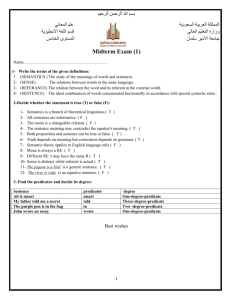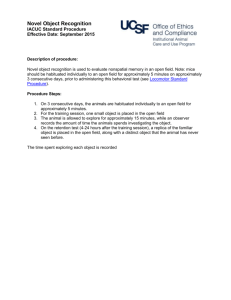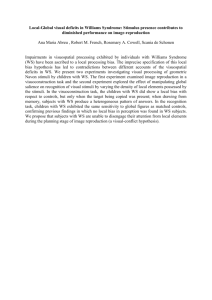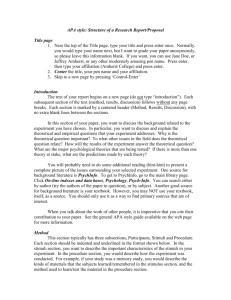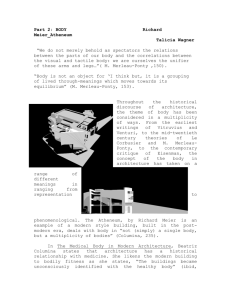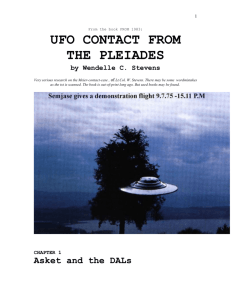How Children Learn Signs for Objects: Testing the Nature of
advertisement
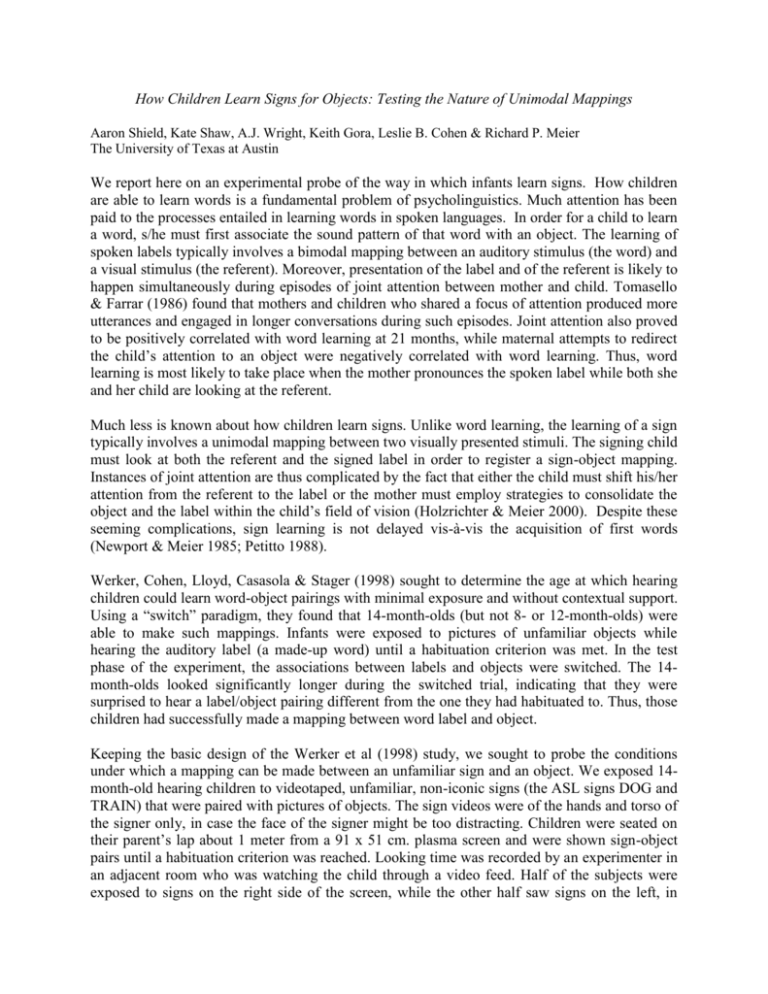
How Children Learn Signs for Objects: Testing the Nature of Unimodal Mappings Aaron Shield, Kate Shaw, A.J. Wright, Keith Gora, Leslie B. Cohen & Richard P. Meier The University of Texas at Austin We report here on an experimental probe of the way in which infants learn signs. How children are able to learn words is a fundamental problem of psycholinguistics. Much attention has been paid to the processes entailed in learning words in spoken languages. In order for a child to learn a word, s/he must first associate the sound pattern of that word with an object. The learning of spoken labels typically involves a bimodal mapping between an auditory stimulus (the word) and a visual stimulus (the referent). Moreover, presentation of the label and of the referent is likely to happen simultaneously during episodes of joint attention between mother and child. Tomasello & Farrar (1986) found that mothers and children who shared a focus of attention produced more utterances and engaged in longer conversations during such episodes. Joint attention also proved to be positively correlated with word learning at 21 months, while maternal attempts to redirect the child’s attention to an object were negatively correlated with word learning. Thus, word learning is most likely to take place when the mother pronounces the spoken label while both she and her child are looking at the referent. Much less is known about how children learn signs. Unlike word learning, the learning of a sign typically involves a unimodal mapping between two visually presented stimuli. The signing child must look at both the referent and the signed label in order to register a sign-object mapping. Instances of joint attention are thus complicated by the fact that either the child must shift his/her attention from the referent to the label or the mother must employ strategies to consolidate the object and the label within the child’s field of vision (Holzrichter & Meier 2000). Despite these seeming complications, sign learning is not delayed vis-à-vis the acquisition of first words (Newport & Meier 1985; Petitto 1988). Werker, Cohen, Lloyd, Casasola & Stager (1998) sought to determine the age at which hearing children could learn word-object pairings with minimal exposure and without contextual support. Using a “switch” paradigm, they found that 14-month-olds (but not 8- or 12-month-olds) were able to make such mappings. Infants were exposed to pictures of unfamiliar objects while hearing the auditory label (a made-up word) until a habituation criterion was met. In the test phase of the experiment, the associations between labels and objects were switched. The 14month-olds looked significantly longer during the switched trial, indicating that they were surprised to hear a label/object pairing different from the one they had habituated to. Thus, those children had successfully made a mapping between word label and object. Keeping the basic design of the Werker et al (1998) study, we sought to probe the conditions under which a mapping can be made between an unfamiliar sign and an object. We exposed 14month-old hearing children to videotaped, unfamiliar, non-iconic signs (the ASL signs DOG and TRAIN) that were paired with pictures of objects. The sign videos were of the hands and torso of the signer only, in case the face of the signer might be too distracting. Children were seated on their parent’s lap about 1 meter from a 91 x 51 cm. plasma screen and were shown sign-object pairs until a habituation criterion was reached. Looking time was recorded by an experimenter in an adjacent room who was watching the child through a video feed. Half of the subjects were exposed to signs on the right side of the screen, while the other half saw signs on the left, in order to control for any side preferences. Subjects were also counter-balanced for sex. Furthermore, half the subjects were exposed to conventional sign-object pairings (i.e., a picture of a dog would be shown alongside the ASL sign DOG), while the other half were habituated to a “switched” sign-object pairing that did not correspond to the conventional pairing (i.e., a picture of a dog shown with the sign TRAIN), in order to control for any effects of iconicity. The order of presentation of stimuli was randomized. In a pilot study with 6 subjects, children proved to be far more interested in the signs than in the static pictures of objects, looking at the signs about 73% of the time on average. In the test phase, children did not look significantly longer at switched sign-object pairings than at familiar ones. On the hypothesis that the children must look more equally at sign and object in order to establish a sign-object mapping, we redesigned our stimuli so the object pictures would move up and down on the screen during presentation. The second experiment with the revised stimuli had 20 subjects. Children looked on average equally long at both sign and object stimuli (about 54% and 46% of total looking time, respectively), thus rectifying the problem with Study 1. Of 20 subjects, 6 habituated to the stimuli but 14 did not. In the test phase, neither the children who had habituated nor the nonhabituators looked significantly longer at the switched sign-object pairings, indicating that a mapping between sign and object had not occurred. We reasoned that it might have been unclear to the children that an event of labeling was taking place on the screen in front of them. We decided to redesign the stimuli once again in order to provide a social context suggestive that the signs were functioning as object labels. The new stimuli show a deaf woman pointing to an object and then performing the associated sign, thus making it more obvious that the sign is an object label. This experiment is ongoing; our expectation is that this richer context will aid infants to establish sign-object mappings. 32 subjects will be run in this study. We expect that, under these conditions, 14-month-olds will look longer at unfamiliar sign-object pairings than at those to which they have been exposed, thus indicating sign learning. Our studies will help clarify under what conditions sign-object mappings take place, and how such mappings differ from spoken language word-object mappings. Holzrichter, A. S., & R. P. Meier. 2000. Child-directed signing in American Sign Language. In Chamberlain, C., Morford, J.P., & Mayberry, R. I. (eds.), Language acquisition by eye. Mahwah, NJ: Erlbaum, 25-40. Newport, E. L., & Meier, R. P. 1985. The acquisition of American Sign Language. In D. I. Slobin (ed.), The crosslinguistic study of language acquisition. Volume 1: The data. Hillsdale, NJ: Erlbaum, 881-938. Petitto, L. A. 1988. "Language" in the pre-linguistic child. In F. S. Kessel (ed.), The development of language and language researchers. Hillsdale, NJ: Erlbaum, 187-221. Tomasello, M., & M. J. Farrar. 1986. Joint attention and early language. Child Development 57, 1454-1463. Werker, J.F., Cohen, L.B., Lloyd, V.L., Casasola, M., & Stager, C.L. 1998. Acquisition of wordobject associations by 14-month-old infants. Developmental Psychology, 34, 1289-1309.

